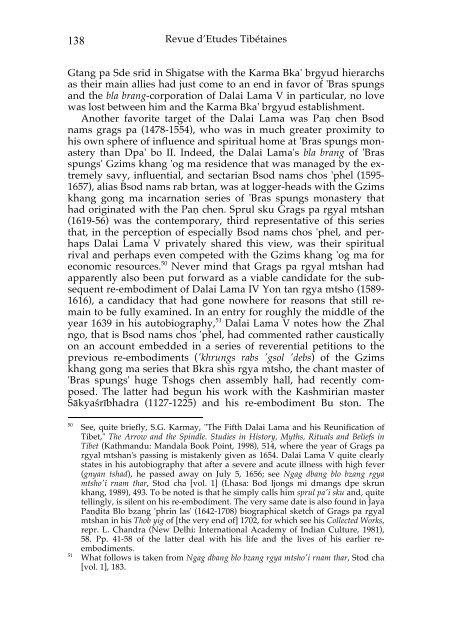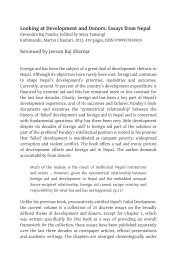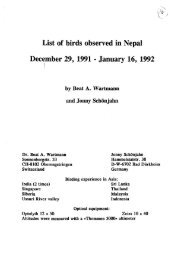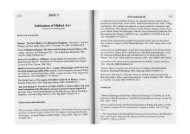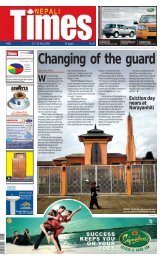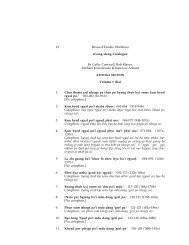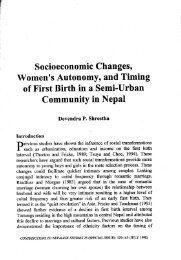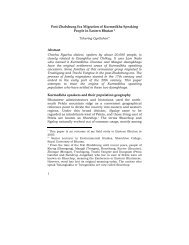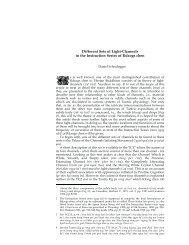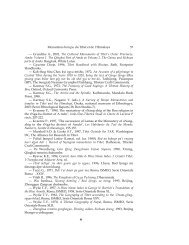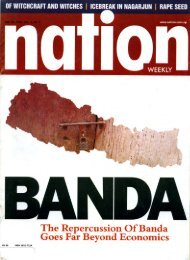Some Remarks on the Textual Transmission and Text of Bu ston
Some Remarks on the Textual Transmission and Text of Bu ston
Some Remarks on the Textual Transmission and Text of Bu ston
You also want an ePaper? Increase the reach of your titles
YUMPU automatically turns print PDFs into web optimized ePapers that Google loves.
138<br />
Revue d’Etudes Tibétaines<br />
Gtang pa Sde srid in Shigatse with <strong>the</strong> Karma Bka' brgyud hierarchs<br />
as <strong>the</strong>ir main allies had just come to an end in favor <strong>of</strong> 'Bras spungs<br />
<strong>and</strong> <strong>the</strong> bla brang-corporati<strong>on</strong> <strong>of</strong> Dalai Lama V in particular, no love<br />
was lost between him <strong>and</strong> <strong>the</strong> Karma Bka' brgyud establishment.<br />
Ano<strong>the</strong>r favorite target <strong>of</strong> <strong>the</strong> Dalai Lama was Paṇ chen Bsod<br />
nams grags pa (1478-1554), who was in much greater proximity to<br />
his own sphere <strong>of</strong> influence <strong>and</strong> spiritual home at 'Bras spungs m<strong>on</strong>astery<br />
than Dpa' bo II. Indeed, <strong>the</strong> Dalai Lama's bla brang <strong>of</strong> 'Bras<br />
spungs' Gzims khang 'og ma residence that was managed by <strong>the</strong> extremely<br />
savy, influential, <strong>and</strong> sectarian Bsod nams chos 'phel (1595-<br />
1657), alias Bsod nams rab brtan, was at logger-heads with <strong>the</strong> Gzims<br />
khang g<strong>on</strong>g ma incarnati<strong>on</strong> series <strong>of</strong> 'Bras spungs m<strong>on</strong>astery that<br />
had originated with <strong>the</strong> Paṇ chen. Sprul sku Grags pa rgyal mtshan<br />
(1619-56) was <strong>the</strong> c<strong>on</strong>temporary, third representative <strong>of</strong> this series<br />
that, in <strong>the</strong> percepti<strong>on</strong> <strong>of</strong> especially Bsod nams chos 'phel, <strong>and</strong> perhaps<br />
Dalai Lama V privately shared this view, was <strong>the</strong>ir spiritual<br />
rival <strong>and</strong> perhaps even competed with <strong>the</strong> Gzims khang 'og ma for<br />
ec<strong>on</strong>omic resources. 50 Never mind that Grags pa rgyal mtshan had<br />
apparently also been put forward as a viable c<strong>and</strong>idate for <strong>the</strong> subsequent<br />
re-embodiment <strong>of</strong> Dalai Lama IV Y<strong>on</strong> tan rgya mtsho (1589-<br />
1616), a c<strong>and</strong>idacy that had g<strong>on</strong>e nowhere for reas<strong>on</strong>s that still remain<br />
to be fully examined. In an entry for roughly <strong>the</strong> middle <strong>of</strong> <strong>the</strong><br />
year 1639 in his autobiography, 51 Dalai Lama V notes how <strong>the</strong> Zhal<br />
ngo, that is Bsod nams chos 'phel, had commented ra<strong>the</strong>r caustically<br />
<strong>on</strong> an account embedded in a series <strong>of</strong> reverential petiti<strong>on</strong>s to <strong>the</strong><br />
previous re-embodiments ('khrungs rabs 'gsol 'debs) <strong>of</strong> <strong>the</strong> Gzims<br />
khang g<strong>on</strong>g ma series that Bkra shis rgya mtsho, <strong>the</strong> chant master <strong>of</strong><br />
'Bras spungs' huge Tshogs chen assembly hall, had recently composed.<br />
The latter had begun his work with <strong>the</strong> Kashmirian master<br />
Śākyaśrībhadra (1127-1225) <strong>and</strong> his re-embodiment <strong>Bu</strong> st<strong>on</strong>. The<br />
50<br />
51<br />
See, quite briefly, S.G. Karmay, "The Fifth Dalai Lama <strong>and</strong> his Reunificati<strong>on</strong> <strong>of</strong><br />
Tibet," The Arrow <strong>and</strong> <strong>the</strong> Spindle. Studies in History, Myths, Rituals <strong>and</strong> Beliefs in<br />
Tibet (Kathm<strong>and</strong>u: M<strong>and</strong>ala Book Point, 1998), 514, where <strong>the</strong> year <strong>of</strong> Grags pa<br />
rgyal mtshan's passing is mistakenly given as 1654. Dalai Lama V quite clearly<br />
states in his autobiography that after a severe <strong>and</strong> acute illness with high fever<br />
(gnyan tshad), he passed away <strong>on</strong> July 5, 1656; see Ngag dbang blo bzang rgya<br />
mtsho'i rnam thar, Stod cha [vol. 1] (Lhasa: Bod lj<strong>on</strong>gs mi dmangs dpe skrun<br />
khang, 1989), 493. To be noted is that he simply calls him sprul pa'i sku <strong>and</strong>, quite<br />
tellingly, is silent <strong>on</strong> his re-embodiment. The very same date is also found in Jaya<br />
Paṇḍita Blo bzang 'phrin las' (1642-1708) biographical sketch <strong>of</strong> Grags pa rgyal<br />
mtshan in his Thob yig <strong>of</strong> [<strong>the</strong> very end <strong>of</strong>] 1702, for which see his Collected Works,<br />
repr. L. Ch<strong>and</strong>ra (New Delhi: Internati<strong>on</strong>al Academy <strong>of</strong> Indian Culture, 1981),<br />
58. Pp. 41-58 <strong>of</strong> <strong>the</strong> latter deal with his life <strong>and</strong> <strong>the</strong> lives <strong>of</strong> his earlier reembodiments.<br />
What follows is taken from Ngag dbang blo bzang rgya mtsho'i rnam thar, Stod cha<br />
[vol. 1], 183.


